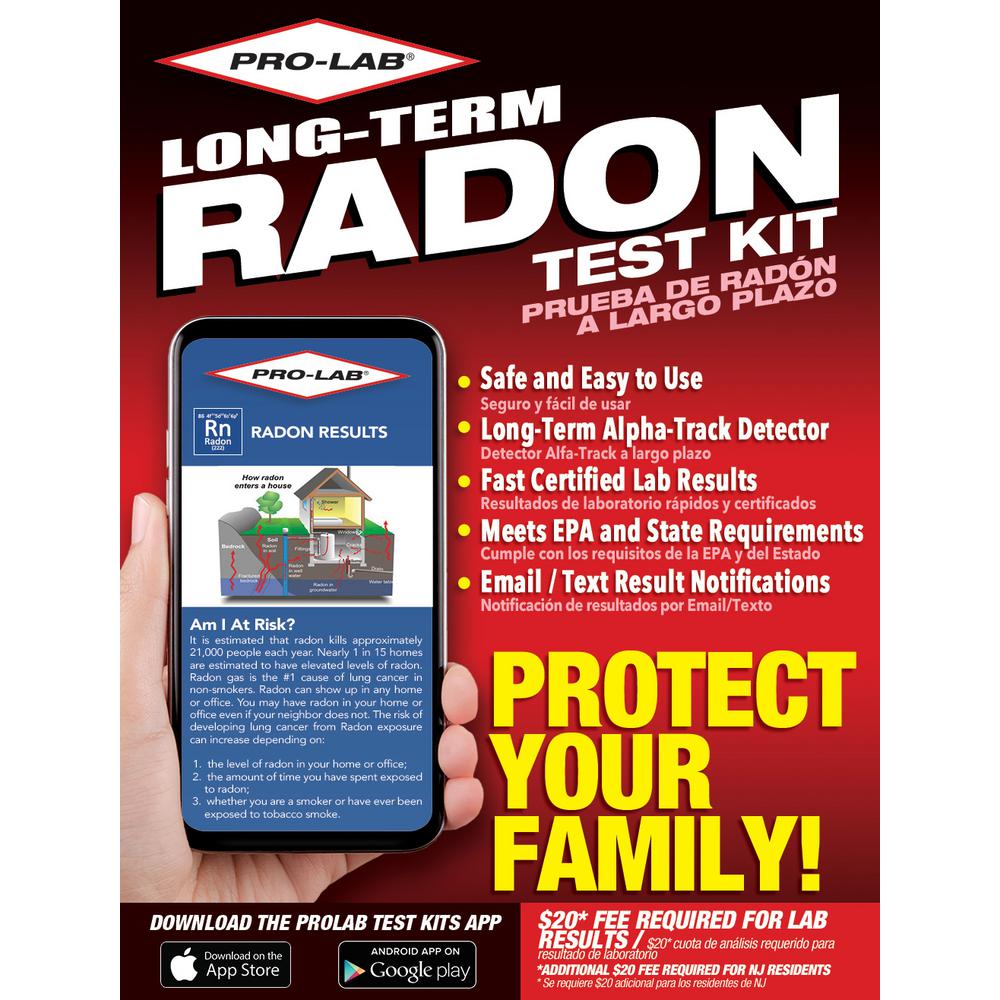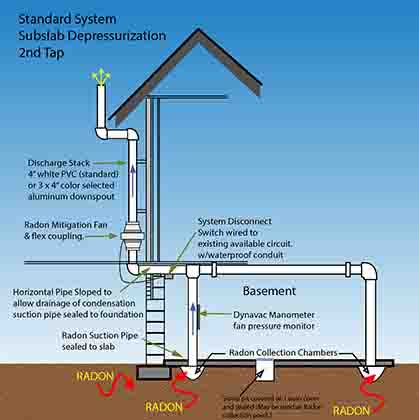Radon gas in buildings
The very first battery-operated clever indoor air quality monitor with Radon detection, consisting of sensing units for temperature level, atmospheric pressure, moisture, VOCs, as well as CO2. Picocuries per liter of air, or pCi/L, which is among the preferred measurements for the rate of decay in radon, amounts to one trillionth of a curie, abbreviated as pCi. Since it is needed by federal legislation, the pCi system is utilized in the United States.
Is radon something to worry about?
The average home has about 1.3 pCi/L of radon. Such levels aren't enough to worry about, but under the right conditions, they could make you sick. According to the EPA, a nonsmoker who was exposed to average levels of radon for a lifetime would have a 1 in 500 risk of developing lung cancer.
Some States preserve lists of service providers readily available in their state or they have effectiveness programs or requirements of their own. The system attracts the radon-laden dirt gas from under the foundation and also exhausts it beyond the building, far enough away from windows and other openings that it will not reenter. The system typically contains a plastic pipe connected to the dirt via an opening in a piece flooring, with a sump lid link, or beneath a plastic sheet in a crawl area.
What are the chances of getting lung cancer from radon?
Granite, like any other stone, may contain veins of naturally occurring radioactive elements like uranium, thorium, and their radioactive decay products. If present, uranium, thorium or radium will decay into radon, a colorless, odorless, radioactive gas that may cause lung cancer.
Misconception 3: Testing your house for radon is expensive as well as time-consuming.
It's good to just deal with it during your real estate deal. Often the seller spends for everything, often they money a credit and occasionally there is a split. the rate of exchange in between indoor as well as exterior air, which depends upon the building and construction of your home, the air flow behaviors of the inhabitants, and also the air-tightness of the structure. Radon is created from the all-natural radioactive degeneration of uranium, which is discovered in all rocks and also dirt. And also it isn't as costly to hire a professional as you might think.
Can you smell radon?
The “safe†level of radon exposure is no radon at all. The EPA's recommended level for radon mitigation is 4.0 pCi/L or above. It's estimated that 1 in 15 American homes have an elevated level of radon gas.

Radon: A Risk in Your Home
How do I make my house safe from radon?
Install a layer of gas-permeable aggregate, such as four inches of gravel, beneath the slab or flooring system of your home if you don't have a crawlspace. Cover this layer or your crawlspace floor with plastic sheeting to stop radon gas from moving past that level and into your home.
"The examination is low-cost and also trusted-- it does not take rocket science," states Costs Wehrum, a manager at the EPA's Workplace of Air as well as Radiation. Testing for radon is simple as well as relatively cost-effective to do, so do not think twice to begin. And if you do discover that there's too much radon in your home, there are known solutions to make your home a much safer area.
Without the appropriate equipment or technological understanding, you might in fact enhance your radon degree or develop various other possible hazards as well as extra prices. Certified professionals can be situated with state radon workplaces, which are detailed on the EPA web site at/ radon/whereyoulive. html. If you choose to do the job on your own, make sure you have the proper training and also tools. The https://essokef60q.picturepush.com/profile proof that radon triggers lung cancer comes from researches in studies as well as people carried out in the laboratory.
Can I install my own radon mitigation system?
In most cases, pros charge about $1,500 to install a radon mitigation system, but you can do it yourself for only about $500 in materials. So if you're fairly handy and have some carpentry, plumbing and electrical skills, you can install your own system in a weekend and save yourself a thousand bucks!
How long does radon stay in the air?
It can be found in all 50 states. Once produced, radon moves through the ground to the air above. Some remains below the surface and dissolves in water that collects and flows under the ground's surface. Radon has a half-life of about four days - half of a given quantity of it breaks down every four days.
Why is radon bad for you?
Radon produces a radioactive dust in the air we breathe. The dust is trapped in our airways and emits radiation that damages the inside of our lungs. This damage, like the damage caused by smoking, increases our risk of lung cancer.
How common is radon in a home?
It's common: About 1 in every 15 homes has what's considered an elevated radon level. The gas is odorless and invisible, says the EPA, and it causes no immediate symptoms, so the only way to know if your home is affected is by testing your individual residence.
- When its validated radon level is 2.7 pCi/L or above, the Globe Wellness Organization suggest that a house be mitigated.
- This option allows general threats from exposure to radon, both through air and water, to be reduced.
- High levels of radon in residences can be properly remediated by securing such entry points and also by setting up sufficient ventilation.
- No degree of radon exposure is taken into consideration entirely risk-free, nevertheless the EPA just recommends minimizing radon degrees in your home if your long-lasting direct exposure standards 4 picocuries per litre (pCI/L) or greater.
- The systems develop consistent vacuum cleaner in the soil under basements, concrete pieces and crawlspaces.
Should I buy a house with high radon?

EPA RECOMMENDS: If you are buying or selling a home, have it tested for radon. For a new home, ask if radon-resistant construction features were used and if the home has been tested. Fix the home if the radon level is 4 picocuries per liter (pCi/L) or higher.
Is a radon level of 5 bad?
Safe radon levels. The best radon level measurement would be zero. The average global outdoor radon level varies between 5-15 Bq/m3, equal to 0.135-0.405 pCi/L. For every 99.9 Bq/m3, or every 2.7 pCI/L increase in long term radon exposure, lung cancer risk rises 16 percent.
Who is most at risk of lung cancer?
The more uranium there is, the more radon there is. That makes radon the second leading cause of lung cancer after smoking. But even minor symptoms like headaches, feeling unusually tired, itching or burning eyes, irritated skin, nasal congestion, a dry throat or nausea could be due to your home's indoor air quality.
What do you do if your house has radon?
Radon can seep into any home that is in contact with the ground. It is undetectable unless you perform a radon test. It is the second leading cause of lung cancer and according to the EPA and CDC, it kills more than 20,000 annually. It is not something you want in the home you are buying.
Is radon only in the basement?
Radon is completely odorless as well as being invisible. Because it is often found unexpectedly in basements, some people mistakenly believe that it only occurs in basements. Most commonly homes with basements are suspect for having higher radon levels.
Is radon really a big deal?
Radon is a radioactive gas that has been found in homes all over the United States. It comes from the natural breakdown of uranium in soil, rock, and water and gets into the air you breathe. Radon typically moves up through the ground to the air above and into your home through cracks and other holes in the foundation.
How do you eliminate radon?
If a person has been exposed to radon, 75 percent of the radon progeny in lungs will become "harmless" lead particles after 44 years. When an alpha particle damages a cell to make it cancerous, the onset of lung cancer takes a minimum of 5 years but most often 15 to 25 years, and even longer.
How effective is radon remediation?
The Surgeon General and the EPA recommend testing for radon and reducing radon in homes that have high levels. Fix your home if your radon level is confirmed to be 4 picocuries per liter (pCi/L) or higher. Radon reduction systems work. Some radon reduction systems can reduce radon levels in your home by up to 99%.
What causes radon?
Being exposed to radon for a long period of time can lead to lung cancer. Radon gas in the air breaks down into tiny radioactive elements (radon progeny) that can lodge in the lining of the lungs, where they can give off radiation. This radiation can damage lung cells and eventually lead to lung cancer.
How do you get rid of radon gas in a basement?
The radon fans are guaranteed by manufacturers for 3 – 5 years. Their replacement cost, including installation, is usually $300 to $600. Homeowners are aware that the fan must run continuously 24/7, year after year. The typical estimate of the electricity cost is $150 per year.
Do all homes have some level of radon?
The EPA estimates the lifetime risk of radon-induced lung cancer for never-smokers at 7 per 1,000 people, compared with 62 per 1,000 for smokers exposed to a level of 4 pCi/L. Your risk goes up with your exposure to radon and cigarette smoke over time.
Is a radon level of 2 safe?
Radon levels are measured in picocuries per liter, or pCi/L. Levels of 4 pCi/L or higher are considered hazardous. Radon levels less than 4 pCi/L still pose a risk and in many cases can be reduced, although it is difficult to reduce levels below 2 pCi/L. Once installed, a follow-up radon test is done.